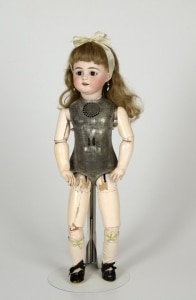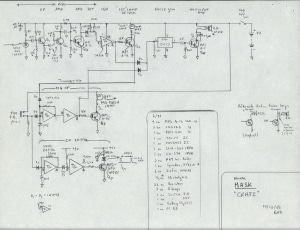Ralph Baer is perhaps best known as the father of home video games. He patented the idea for playing a video game on a television and then successfully developed the first home video game system, the Magnavox Odyssey, that came out in 1972. And yet Baer’s work on video games was only one small part of a lifetime of inventing. He had worked for decades in the defense industry, ultimately heading a major engineering division of Sanders, a large military contractor. And in the 1970s—after the success of the Odyssey—he became an active creator of many successful electronic toys. Ralph Baer’s work on these toys continued until his death in 2015, meaning that he worked on electronic toys far longer than he spent developing video games. And now his family has donated to The Strong a collection of prototypes and products that showcase his four decades of work as a toy inventor.
 To understand how Ralph Baer’s career developed, it’s useful to begin with a broader perspective on how computers were transforming play in the 1970s. The toy industry has always adapted new technologies to produce new products. Thomas Edison created a talking doll in the 1880s that used wax cylinders to produce sounds, though the piercing shrieks of the doll were so unsettling that the toy flopped [insert photo of Edison’s talking doll]. Similarly, in the 1960s Marvin Glass & Associates took advantage of the widescale adoption of plastic injection molding to create hits like Mr. Machine and Mousetrap. And, as it turned out, Marvin Glass & Associates would also be a key player in facilitating Ralph Baer’s turn to toys.
To understand how Ralph Baer’s career developed, it’s useful to begin with a broader perspective on how computers were transforming play in the 1970s. The toy industry has always adapted new technologies to produce new products. Thomas Edison created a talking doll in the 1880s that used wax cylinders to produce sounds, though the piercing shrieks of the doll were so unsettling that the toy flopped [insert photo of Edison’s talking doll]. Similarly, in the 1960s Marvin Glass & Associates took advantage of the widescale adoption of plastic injection molding to create hits like Mr. Machine and Mousetrap. And, as it turned out, Marvin Glass & Associates would also be a key player in facilitating Ralph Baer’s turn to toys.
In 1976, Baer attended the Music Operators of America (MOA) trade show that featured many of the latest coin-operated games. At that time there was as of yet no organized video game industry, and so there were no dedicated trade shows for video games like the E3 convention that would later develop. In their early years, arcade video games often fell into the category of coin-operated amusements, a market segment that had long been covered by the music industry that had an interest in coin-operated machines like juke boxes (Billboard magazine, for example, is the prime source of coverage of the coin-operated games industry for much of the 20th century). Baer was attending the MOA show on behalf of Magnavox to check for products that might be infringing on Magnavox’s patents for video games, and there he saw an Atari game called touch-me that he thought had potential. As he stated in his autobiography, while the game had “nice game-play” it also had “terrible execution, [was] visually boring, and [had] miserable, rasping sounds.” He could do better.
But he needed affordable electronics to do so, and electronics were just starting to transform the toy business. Baer’s early work on electronics and video games relied on analog circuits, but by the 1970s microelectronics were becoming cheaper and more available. In 1974, Texas Instruments introduced the TMS-1000 microprocessor chip, a revolutionary microcontroller that was powerful, cheap enough to be used in consumer products like toys, and adaptable to a wide variety of needs. Texas Instruments would make waves in the electronic toy market with hit products like Little Professor and Speak -n- Spell. Baer realized he could use the TMS-1000 to create Simon, a musical improvement on the lackluster touch-me game that he had seen at the 1976 MOA trade show.
Luckily for Baer, he had the year before begun working with Marvin Glass & Associates as an outside consultant. Now he worked with Marvin Glass to develop Simon, a handheld game in which players remembered and repeated a sequence of lights and musical tones. Milton Bradley released Simon in 1978 and it went on to become a best-selling toy that is still on toy shelves today.
Buoyed by the success of Simon, Ralph Baer undertook more work in the electronic toy market, developing electronic handheld games like Amaze-A-Tron, Maniac, and Computer Perfection. For the next 30 years he kept inventing—animatronic teddy bears, talking greeting cards, cool bicycle accessories, and lots of toys that had electronic components that sensed, sounded, and signaled. I got to know Ralph well in his later years, and whenever I stopped by his house, he showed me the latest toy he was working on. Even to the end of his life in his 90s he experimented with ways that electronics could enable toys to have new features. He displayed many of the prototypes and finished products of these toys on shelves next to his basement workshop, and he would stop by these shelves, lovingly recounting his work on each product, noting the obstacles he had to overcome, and taking pride in each one.
These are the toys that Ralph Baer’s family has now donated to The Strong. The collection includes dozens of versions, from prototypes to final product. This collection is especially important because it complements Ralph’s personal papers documenting his work on toys that he previously donated to The Strong.
 In the archives we even have video footage of Ralph demonstrating some of these prototypes. Ralph Baer imagined a Paramedic Rescue Playset for G.I. Joe, for example, that would let people take the temperature of a patient, insert an IV, take a blood pressure, and do other things to enhance the play with sounds and lights. One video in our archives—likely made to pitch the product to potential manufacturers—shows Ralph demonstrating the prototype by acting out a rescue scene.
In the archives we even have video footage of Ralph demonstrating some of these prototypes. Ralph Baer imagined a Paramedic Rescue Playset for G.I. Joe, for example, that would let people take the temperature of a patient, insert an IV, take a blood pressure, and do other things to enhance the play with sounds and lights. One video in our archives—likely made to pitch the product to potential manufacturers—shows Ralph demonstrating the prototype by acting out a rescue scene.
More explosive than G.I. Joe was the augmented MASK Laser Command vehicle. Created by Kenner, the MASK toy line debuted in 1985 and featured a series of different vehicles that had special surprise features. The toys were part of an overall lineup that included a MASK animated series, comic books, and even some computer games from British game company Gremlin, an early example of what people in the industry today often refer to as “transmedia.” Ralph Baer’s personal papers at The Strong provide a nice window into how he developed the MASK Laser Command for Kenner.
 The papers begin with an initial schematic and toy design he developed in 1986. In a conversation with his design partner Jay Smith III on April 1, 1986, he noted that the toy should make sounds and have a detachable unit shaped as a crate or a barrel (it would become a crate) that would activate the sounds and lights in the unit via infrared. Kenner was enthusiastic about the idea, and by October of that year Ralph was refining the schematics. In October he met with Jay Smith III and Howard Bollinger of Kenner, and he noted that Kenner’s Centurions line was selling poorly, so they should concentrate on MASK and make the “modules exciting, outlandish.” Ralph finished design refinements (e.g. moving the speaker in the crate so that the figure could sit down) that October, demonstrated it at Toy Fair in February of 1987, and it was in production/delivery for Christmas of 1987.
The papers begin with an initial schematic and toy design he developed in 1986. In a conversation with his design partner Jay Smith III on April 1, 1986, he noted that the toy should make sounds and have a detachable unit shaped as a crate or a barrel (it would become a crate) that would activate the sounds and lights in the unit via infrared. Kenner was enthusiastic about the idea, and by October of that year Ralph was refining the schematics. In October he met with Jay Smith III and Howard Bollinger of Kenner, and he noted that Kenner’s Centurions line was selling poorly, so they should concentrate on MASK and make the “modules exciting, outlandish.” Ralph finished design refinements (e.g. moving the speaker in the crate so that the figure could sit down) that October, demonstrated it at Toy Fair in February of 1987, and it was in production/delivery for Christmas of 1987.
Having such a systematic record of the work of such a significant inventor in the video game and toy industry is of paramount importance to scholars. Being able to look at prototypes and examine the working papers of the creator provides a window into the design process at an important moment in the history of electronic games and toys. It’s also of interest to anyone who is curious about how products like these get developed.
This collection of Ralph Baer’s prototypes and products are also an inspiration. F. Scott Fitzgerald famously wrote that “there are no second acts in American lives.” Ralph Baer’s life refutes that. His professional life had at least three distinct acts: he was a highly successful engineer in the defense industry, the progenitor of home video games, and lastly a prolific inventor of electronic toys. Such a successful career was made possible by his boundless curiosity, his incessant drive, and his knack for coaxing maximum play value out of new technologies. Those qualities are ones that any of us might benefit from emulating, and so The Strong is proud to care for these products and grateful to Ralph Baer’s family for donating them.
By Jon-Paul Dyson, Director, International Center for the History of Electronic Games and Vice President for Exhibits



